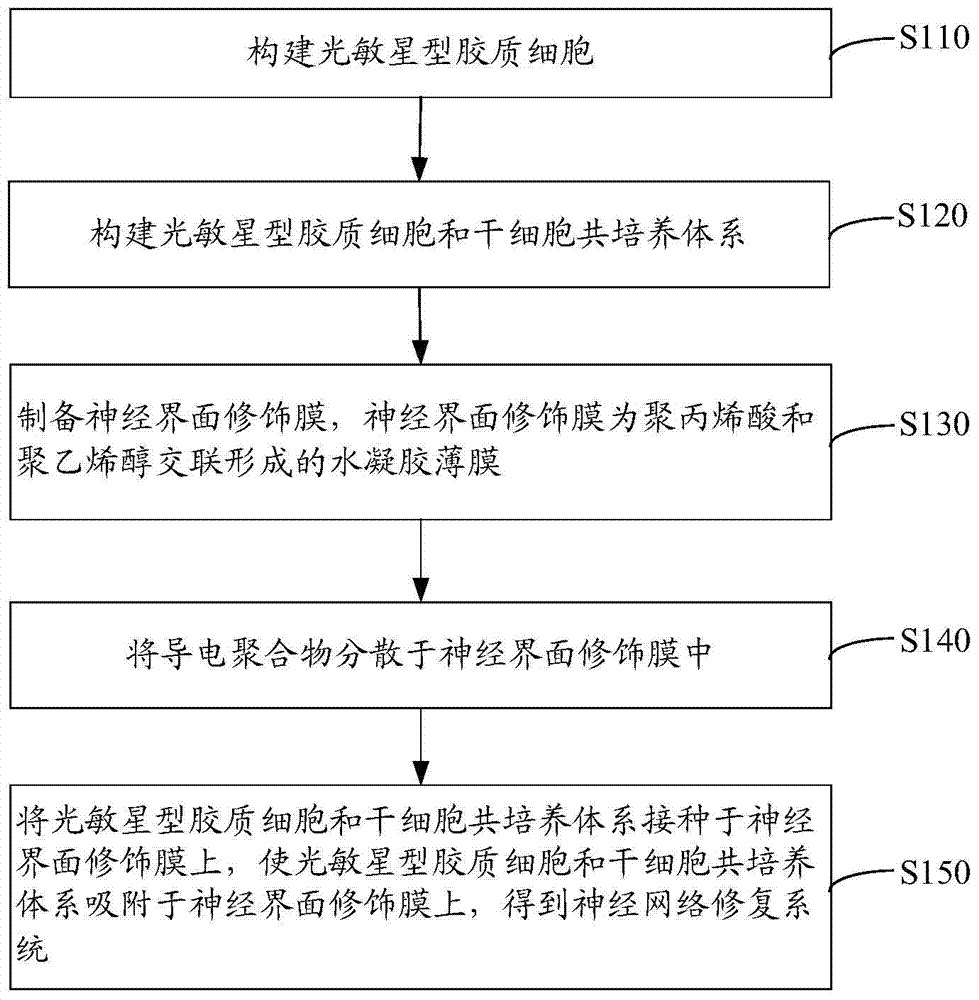Nervous network restoration system, as well as preparation method and application thereof
A technology for repairing systems and neural networks, applied to nervous system diseases, biochemical equipment and methods, applications, etc., can solve the problems of lack of cell specificity, time controllability, poor curative effect, etc., to overcome transient release, Effects of promoting proliferation and repairing damaged neural networks
- Summary
- Abstract
- Description
- Claims
- Application Information
AI Technical Summary
Problems solved by technology
Method used
Image
Examples
preparation example Construction
[0068] see figure 1 , a method for preparing a neural network repair system according to an embodiment includes the following steps S110 to S150.
[0069] Step S110: constructing photosensitive astrocytes.
[0070] Photosensitive astrocytes are jointly constructed by astrocytes, photosensitive genes and viral vectors carrying photosensitive genes.
[0071] The astrocytes are preferably animal hippocampal astrocytes or striatal astrocytes.
[0072] The photosensitive gene is preferably ChR2. Viral vectors can be lentiviruses or adenoviruses.
[0073] Liposomes were used to transfect fusion plasmids containing light-sensitive genes, green fluorescent marker genes, and the promoter GFAP for specific labeling of glial cells, as well as mixed plasmids pCMVΔR8.74 and pMD2.G. related to lentiviral packaging, into 293FT cells , 6L liposomes per 200,000 293FT cells.
[0074] Among them, the structure of the fusion plasmid containing the photosensitive gene, the green fluorescent m...
Embodiment 1
[0106] Preparation of neural network repair system
[0107] (1) Construction of photosensitive astrocytes
[0108] The humanized GFAP-ChR2 codon (obtained from the laboratory of Professor Karl Deisseroth at Stanford University) was integrated into the N-terminal of the open framework plasmid pCS2-eYFP (purchased by Clotech) through the HindIII / BamHI restriction site. The successfully constructed plasmid was purified and amplified by Qiagen's maxiprep kit to obtain a fusion plasmid containing a light-sensitive gene, a green fluorescent marker gene, and a promoter GFAP for specifically labeling glial cells. The forward primer sequence for PCR amplification is the sequence shown in SEQ ID No.1, the reverse primer sequence is the sequence shown in SEQ ID No.2, and the source of GFAP is human.
[0109] Use liposomes to transfect 0.5 μg fusion plasmid containing photosensitive gene, green fluorescent marker gene and promoter GFAP for specific labeling of glial cells, and 1.5 μg mix...
Embodiment 2
[0148] Preparation of neural network repair system
[0149] (1) Construction of photosensitive astrocytes
[0150] Method is with embodiment 1.
[0151] (2) Detection of photosensitive astrocyte excitability and cell membrane integrity
[0152] Method is with embodiment 1.
[0153] (3) Construction of co-culture system of photosensitive astrocytes and stem cells
[0154] Method is with embodiment 1.
[0155] (4) Preparation of sustained release film
[0156] Method is with embodiment 1.
[0157] (5) Coat the slow-release film on the surface of the nerve electrode and dry it.
[0158] (6) Disperse the conductive polymer in the sustained release film
[0159] The nerve electrode coated with the hydrogel film is fully swollen in the electrodeposition solution containing the conductive polymer monomer, neurotrophic substance, nerve growth factor and ATP, so that the solution containing the conductive polymer monomer is evenly distributed on the swollen in the hydrogel film...
PUM
 Login to View More
Login to View More Abstract
Description
Claims
Application Information
 Login to View More
Login to View More - R&D
- Intellectual Property
- Life Sciences
- Materials
- Tech Scout
- Unparalleled Data Quality
- Higher Quality Content
- 60% Fewer Hallucinations
Browse by: Latest US Patents, China's latest patents, Technical Efficacy Thesaurus, Application Domain, Technology Topic, Popular Technical Reports.
© 2025 PatSnap. All rights reserved.Legal|Privacy policy|Modern Slavery Act Transparency Statement|Sitemap|About US| Contact US: help@patsnap.com



